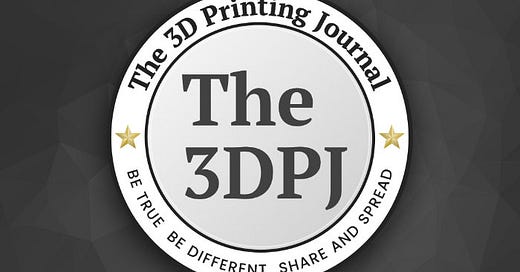Atomic Layer of the Day:
We are in an economic war. That is a fact.
The newly imposed tariffs by Donald Trump could significantly impact European and Asian companies that export 3D printers and 3D printing services to the USA. For now, it all sounds a bit unreal, and it seems many people are counting on Trump being as crazy as the left-wing media portrays him to be, and that just as he imposed the new tariffs, he will suddenly remove them.
Unless he doesn't do it so quickly and easily. In that case, many companies will face problems.
The biggest victim of this war will be Chinese companies, which, as the main exporter of 3D printers to the USA, may experience a significant increase in costs due to tariffs currently reaching 45%. I don't know if this will significantly reduce their market share, but it seems likely to substantially slow down sales.
On the other hand, European countries such as the Czech Republic or the Netherlands, with tariffs at around 25%, will also feel the pressure, but their impact may be less severe thanks to the possibility of local production.
This also applies to suppliers of consumables, of which there are many in Europe.
3D printing services, being intangible, will likely not be directly subject to tariffs, but they may be indirectly affected by trade regulations.
Let me tell you who might benefit from this situation: Prusa Research. The company, which started production in the USA last year, can avoid tariffs on locally produced 3D printers, which could eventually give them a competitive advantage over Chinese manufacturers.
It is possible that Josef Průša, who launched a factory at the headquarters of Printed Solid (acquired in 2023) during last summer – still under Joe Biden's administration – made one of the best business decisions of his career!
The newly imposed tariffs, attributed to the Donald Trump administration, include increased duties on goods imported into the USA, including 3D printers. The administration imposed a 20% general tariff on Chinese goods, with an additional 25% from 2018, potentially resulting in tariffs of up to 45% on budget 3D printers from China, especially after the removal of the de minimis exemption (for packages valued below USD 800).
Chinese manufacturers might raise their prices; for example, the Creality Ender 3 V3 SE could increase from USD 199 to USD 288. This may lead to a drop in demand for Chinese 3D printers in the USA and necessitate adjustments in export strategies.
For goods from Europe, a 25% tariff has been indicated. However, European companies that have invested in local production in the USA can mitigate these effects. Prusa Research started production in the USA last year through its subsidiary Printed Solid in Delaware. Local production allows them to avoid tariffs on finished products, giving them a competitive advantage.
Prusa Research plans to become the largest 3D printer manufacturer in the USA within a year, which allows them to bypass the 25% tariffs on imported products from Europe. However, if they continue to import some components or finished products, those elements may still be subject to tariffs. But this will constitute a relatively small percentage of the total.
So, Prusa stands to gain quite a bit here. Overall, when we look at how everything is shaping up, even last year’s premiere of the Core ONE starts to make a lot of sense—especially in the context of the completely botched American debut of the Bambu Lab H2D by Donald Trump...
It will be interesting in the case of UltiMaker. Here the situation is complex. By default, 3D printers are produced in the Netherlands (all white), so theoretically they are subject to a +25% tariff. On the other hand, MakerBot 3D printers have long been produced in China (since Jonathan Jaglom's term). So it seems that everyone here will be at a disadvantage—unless that Dutch-American conglomerate comes up with some innovative business formula.
Finally, one more, less obvious potential beneficiary of the high tariffs: European filament manufacturers.
Until now, they have significantly lost the competition to the Chinese, who offered much lower prices for filaments—especially the most popular PLA and PETG. Now, the tariff difference is a 20% advantage over Europe. This could also be beneficial in the long run.
Atomic Layer from the Past:
04-06-2020: the President of Poland – Andrzej Duda – demonstrated 3D printing of protective face shields.
Calling all LFAM 3D printers manufacturers!
We’re kicking off recruitment for the new edition of The 3D Printing World Guide — this time, we’re looking for the largest 3D printers from around the world!
📅 Planned release date: April 15, 2025.
News & Gossip:
restor3d, a 3D-printed orthopedic implant company, secured $38M in funding to expand its personalized medical solutions. The funds will drive the launch of four new product lines, including FDA-cleared knee and ankle systems. The company is nearing positive cash flow, enabling further innovation in patient-specific implants for improved surgical outcomes and mobility restoration.
PostProcess Technologies has reached a major milestone by selling its 800th automated post-processing system to PartsToGo GmbH, a leading European 3D printing service provider.
Photocentric has teamed up with Autodesk to enable direct printing from Fusion and Netfabb software to its LC Titan, Magna and Opus LCD 3D printers. This integration eliminates intermediate file conversion steps, streamlining the design-to-print workflow for industrial users. The collaboration combines Photocentric's large-format photopolymer printing expertise with Autodesk's design software, aiming to boost productivity in additive manufacturing. The solution is now available through both companies' platforms.






You are grossly underestimating how many components in each BOM that Prusa imports from China plus the cost of using US labor. There is a reason the Made in USA 3d printer manufacturer landscape is littered with the skeletons of dead 3d printing companies like Printrbot,Makergear,Nexa3d etc. Good strategy for the higher end of the market like government and universities that insist on made in USA products. Not so much for the consumer side of the market.